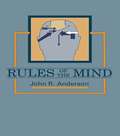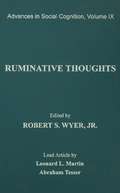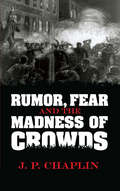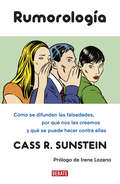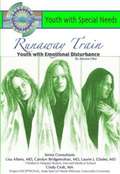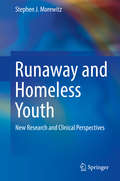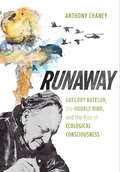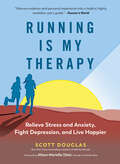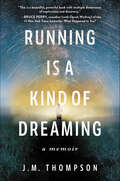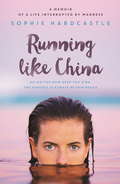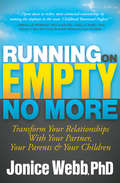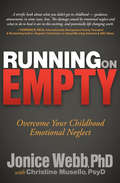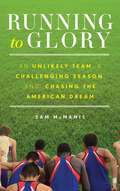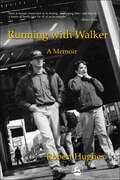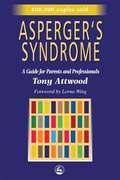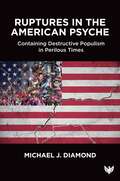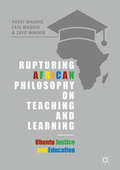- Table View
- List View
Rules of the Mind
by John R. AndersonRelated to the earlier well-known ACT production system theory, this book's basic goal is to present evidence for the psychological reality of a production system model of mind. Distinguished from the original theory in three ways, this volume uses the rational analyses of Anderson (1990) to improve upon that theory and extend its scope. It also relates the theory to a great deal of new data on the performance and acquisition of cognitive skills. The new theory -- ACT-R -- involves a neurally plausible implementation of a production system architecture. Rational analysis is used to structure and parameterize the system to yield optimal information processing. The theory is applicable to a wide variety of research disciplines, including memory, problem solving, and skill acquisition. Using intelligent tutors, much of the data is concerned with the acquisition of cognitive skills. The book provides analyses of data sets describing the extended course of the acquisition of mathematical and computer programming skills.
Rules, Reason, and Self-Knowledge
by Julia TanneyTanney challenges not only the cognitivist approach that has dominated philosophy and the special sciences for fifty years, but metaphysical-empirical approaches to the mind in general. Rules, Reason, and Self-Knowledge advocates a return to the world-involving, circumstance-dependent, normative practices where the rational mind has its home.
Ruling Minds: Psychology in the British Empire
by Erik LinstrumThe British Empire used intelligence tests, laboratory studies, and psychoanalysis to measure and manage the minds of subjects in distant cultures. Challenging assumptions about the role of scientific knowledge in the exercise of power, Erik Linstrum shows that psychology did more to reveal the limits of imperial authority than to strengthen it.
Rumination-Focused Cognitive-Behavioral Therapy for Depression
by Edward R. WatkinsFrom a leading clinician-researcher, this book presents an empirically tested approach for helping clients with severe and chronic depression by directly tackling negative rumination. Rumination-focused cognitive-behavioral therapy (RFCBT) combines carefully adapted elements of CBT with imagery, visualization, and compassion-based techniques. The book provides everything needed to implement this 12-session approach, including numerous sample dialogues, a chapter-length case example, reflections and learning exercises for therapists, and 10 reproducible client handouts. Purchasers get access to a Web page where they can download and print the reproducible materials in a convenient 8 1/2" x 11" size.
Ruminative Thoughts: Advances in Social Cognition, Volume IX (Advances in Social Cognition Series #Vol. 9)
by Robert S. WyerUntil recently, most theory and research in social information processing has focused attention on the cognitive activity that underlies responses to stimulus information presented in the immediate situation being investigated. In contrast, people's thoughts outside the laboratory often concern life events that either have occurred in the past or are likely to occur in the future. Thoughts about such past and future events can be spontaneous and, once elicited, can affect the ability to respond effectively to the demands of the present situation with which one is confronted.This ninth volume in this series focuses on this type of cognitive activity and examines both its determinants and consequences. The lead article, by Leonard Martin and Abraham Tesser, develops a theoretical formulation of ruminative thinking that conceptualizes rumination as a class of conscious thought with a common instrumental theme that recurs in the absence of immediate environmental demands. The authors also give particular attention to the ways in which perceptions of the consequences of past and present events for long-range goal attainment affect both controlled and uncontrolled thinking about these events. They also examine the implications of their theory for the ability to suppress unwanted thoughts, the interplay of emotion and cognition, and the cognitive consequences or rumination for the performance of daily life activities. The entire formulation integrates a number of cognitive phenomena that are not usually considered within a single theoretical framework.The companion chapters, many written by the field's foremost contributors to the literature on emotion and cognition, suggest important refinements and extensions of the conceptualization proposed in the target article. They also make important conceptual contributions in their own right, covering topics that include the role of mental models in cognitive functioning, the dynamics of thought suppression and attentional inhibition, stress and coping, personality correlates of ruminative thought, and attitudes and persuasion. As a result, this volume makes a valuable contribution to research and theory not only in social cognition but also in numerous other areas.
Rumor, Fear and the Madness of Crowds
by J. P. ChaplinMartians, a reincarnated Irish woman, a dead movie star, an insane anesthetist, and an obsessed U.S. Attorney General - these disparate characters have something in common. Each was at the center of an incident of mass hysteria, in which frightened, grieving, and otherwise disturbed people abandoned their common sense. This fascinating book by a prominent psychologist explores several intriguing case histories of mass hysteria, from "The Great Disappointment" of 1926, in which thousands of believers dressed in white to await Jesus' return, to UFO sightings and other extraordinary phenomena.Author J. P. Chaplin examines historical incidents of mob mentality, including "The Last Days of Rudolph Valentino," which culminated in a New York City riot of 80,000 mourning fans; "The Secrets of the Nunnery," involving the sack of a Boston convent by an angry crowd in search of children's skulls; "The Martians Invade New Jersey," in which a radio drama was mistaken for a news broadcast; and other remarkable instances of mass delusion.
Rumorología
by Cass R. Sunstein¿Por qué los seres humanos aceptan los rumores, incluso si son falsos, destructivos o estrambóticos? ¿Por qué la misma historia que viaja por Internet tiene credibilidad entre un grupo de personas, mientras que otros la consideran absurda? ¿Qué podemos hacer para protegernos de los efectos perniciosos de los rumores falsos?Los rumores son tan antiguos como la historia humana; siempre hemos vivido rodeados de ellos o incluso sufrido sus consecuencias. Del mismo modo que a través del conocimiento de otros sabemos que la tierra no es plana o que la materia se compone de átomos, los rumores se propagan entre todo tipo de personas --sensatas, razonables, de izquierdas o derechas---, y están ligados a sus deseos y temores.El derecho de los ciudadanos a decir lo que piensan constituye uno de los pilares de los sistemas democráticos en que vivimos, y sin embargo, en la era de Internet, donde uno de estos bulos puede crecer exponencialmente en tan solo unas horas, es fundamental proteger a las posibles víctimas de comportamientos maldicientes. Ayudado por ejemplos de la vida real y estudios de la conducta, Sunstein aborda la compleja tarea de analizar los mecanismos que alimentan los rumores para tratar de encontrar ese equilibrio indispensable entre la necesidad de protegernos de ellos y la salvaguarda de derechos como la libertad de prensa y opinión, y así evitar que la era de la información termine convirtiéndose en la era de la desinformación.
Run From Fear: Dead Wrong Book 3 (Dead Wrong)
by Jami AldenRun From Fear is an unputdownable novel of romance, suspense, thrills and passion from Jami Alden, perfect for fans of Melinda Leigh, Kendra Elliot, Karen Rose and Laura Griffin.More than anything, Talia Vega wanted to leave behind her harrowing past, and she succeeded...until the one man who knows her darkest secrets wanders into the restaurant where she works. Now the agonizing memories come crashing back - along with an undeniable desire for the ex-Green Beret who rescued her from a sadistic monster. Jack Brooks knows that showing up unannounced is purely selfish. Talia doesn't need his protection, but he can't get the raven-haired beauty out of his mind. And when a twisted madman is hell-bent on resurrecting her torturous past, Jack vows to do anything to keep her safe - even risk his own life to save the only woman he's ever loved.Don't miss more edge-of-the-seat suspense from Jami Alden with her sexy, thrilling novels Beg For Mercy, Hide From Evil and Guilty As Sin.
Run, Don't Walk
by Adele LevineM*A*S*H meets Scrubs in a sharply observant, darkly funny, and totally unique debut memoir from physical therapist Adele Levine. In her six years at Walter Reed Army Medical Center, Adele Levine rehabilitated soldiers admitted in worse and worse shape. As body armor and advanced trauma care helped save the lives--if not the limbs--of American soldiers fighting in Afghanistan and Iraq, Walter Reed quickly became the world leader in amputee rehabilitation. But no matter the injury, physical therapy began the moment the soldiers emerged from surgery. Days at Walter Reed were intense, chaotic, consuming, and heartbreaking, but they were also filled with camaraderie and humor. Working in a glassed-in fishbowl gymnasium, Levine, her colleagues, and their combat-injured patients were on display at every moment to tour groups, politicians, and celebrities. Some would shudder openly at the sight--but inside the glass and out of earshot, the PTs and the patients cracked jokes, played pranks, and compared stumps. With dazzling storytelling, Run, Don't Walk introduces a motley array of oddball characters including: Jim, a retired lieutenant-colonel who stays up late at night baking cake after cake, and the militant dietitian who is always after him; a surgeon who only speaks in farm analogies; a therapy dog gone rogue; --and Levine's toughest patient, the wild, defiant Cosmo, who comes in with one leg amputated and his other leg shattered. Entertaining, engrossing, and ultimately inspiring, Run, Don't Walk is a fascinating look into a hidden world.
Runaway Train: Youth with Emotional Disturbance (Youth with Special Needs)
by Autumn LibalSheila leapt to her feet and tore her sheets from her bed. "Why can't anyone leave me alone?" she screamed. Her lamp crashed to the ground, shards of brown pottery smashing in every direction. She kicked the broken pieces, sending them spinning, then grabbed the nightstam heaved it onto the remains of the lamp. Her screams continued as she grabbed three jars of paint from her dresser. "I HATE YOU!" The jars exploded against the door like punctuation marks for her words. Black, red, and blue paint oozed down the wood, a grand finale to Sheila's performance. Panting, Sheila stared at the broken glass and pottery littering her bedroom floor. As the tears finally bubbled up, Sheila felt a strange sense of awe descending upon her. "What is wrong with me?" she whispered as she sank down on her bed. The tumultuous emotions of youth can be challenging to anyone, but for young people with emotional disturbance, the trials of growing up can be devastating. Young people with emotional disturbance can face many roadblocks in the quest to understand themselves and to gain understanding from others. In Runaway Train: Youth with Emotional Disturbance, you will learn about different causes of emotional disturbance, the special needs of youth who have them, and what can be done to help young people overcome emotional difficulties. Through the story of Sheila, you will learn what it is like to have an emotional disturbance, the dangers these conditions can pose, and the successes as well as the failures of systems currently available to assist youth with emotional disturbance.
Runaway and Homeless Youth
by Stephen J. MorewitzThis straightforward reference surveys the knowledge base on homeless, runaway, and thrown-away children and adolescents and makes concrete recommendations for policy and practice. It is a comprehensive volume, that covers new state legislation in the U. S. dealing with runaway and homeless youth. The book's ecological approach grounds readers in the demographics of this diverse population, family and other risk factors for leaving home (and alternative arrangements such as foster care), and the survival skills homeless young people use to sustain themselves. Chapters cover a gamut of physical, psychological, and social problems, from drug abuse to depression to STIs, with special attention paid to the multiple difficulties faced by LGBT street youth and street youths' experiences with the legal and justice systems. The author also assesses established and emerging interventions used with runaway youth, and the effectiveness of policy initiatives dealing with improving conditions for youth on the streets and at risk. Included in the coverage: · Runaway youth at the time of their disappearance. · Food insecurity and related problems among homeless and runaway youth. · Substance use among homeless and runaway adolescents. · Runaway and homeless sexual minorities. · Court responses to runaway offenses and other juvenile status violations. · Street youth in different countries. Presenting the complex situation as it stands, and with clear suggestions for action, Runaway and Homeless Youth is a valuable resource for family therapists, sociologists, social workers, school administrators, health professionals, police, judges, and other criminal justice professional, along with professionals involved in young people's well-being and policy-making initiatives.
Runaway: Gregory Bateson, the Double Bind, and the Rise of Ecological Consciousness
by Anthony ChaneyThe anthropologist Gregory Bateson has been called a lost giant of twentieth-century thought. In the years following World War II, Bateson was among the group of mathematicians, engineers, and social scientists who laid the theoretical foundations of the information age. In Palo Alto in 1956, he introduced the double-bind theory of schizophrenia. By the sixties, he was in Hawaii studying dolphin communication. Bateson's discipline hopping made established experts wary, but he found an audience open to his ideas in a generation of rebellious youth. To a gathering of counterculturalists and revolutionaries in 1967 London, Bateson was the first to warn of a "greenhouse effect" that could lead to runaway climate change.Blending intellectual biography with an ambitious reappraisal of the 1960s, Anthony Chaney uses Bateson's life and work to explore the idea that a postmodern ecological consciousness is the true legacy of the decade. Surrounded by voices calling for liberation of all kinds, Bateson spoke of limitation and dependence. But he also offered an affirming new picture of human beings and their place in the world—as ecologies knit together in a fabric of meaning that, said Bateson, "we might as well call Mind."
Running Behavioral Studies With Human Participants: A Practical Guide
by Frank E. Ritter Richard A. Carlson Jong W. Kim Jonathan H. MorganRunning Behavioral Experiments With Human Participants: A Practical Guide provides a concrete, practical roadmap for the implementation of experiments and controlled observation using human participants. Covering both conceptual and practical issues critical to implementing an experiment, the book is organized to follow the standard process in experiment-based research, covering such issues as potential ethical problems, risks to validity, experimental setup, running a study, and concluding a study. The detailed guidance on each step of an experiment is ideal for those in both universities and industry who have had little or no previous practical training in research methodology. The book provides example scenarios to help readers organize how they run experimental studies and anticipate problems, and example forms that can serve as effective initial "recipes." Examples and forms are drawn from areas such as cognitive psychology, human factors, human–computer interaction, and human–robotic interaction.
Running Home: A Memoir
by Katie ArnoldIn the tradition of Wild and H Is for Hawk, an Outside magazine writer tells her story—of fathers and daughters, grief and renewal, adventure and obsession, and the power of running to change your life.I’m running to forget, and to remember. For more than a decade, Katie Arnold chased adventure around the world, reporting on extreme athletes who performed outlandish feats—walking high lines a thousand feet off the ground without a harness, or running one hundred miles through the night. She wrote her stories by living them, until eventually life on the thin edge of risk began to seem normal. After she married, Katie and her husband vowed to raise their daughters to be adventurous, too, in the mountains and canyons of New Mexico. But when her father died of cancer, she was forced to confront her own mortality. His death was cataclysmic, unleashing a perfect storm of grief and anxiety. She and her father, an enigmatic photographer for National Geographic, had always been kindred spirits. He introduced her to the outdoors and took her camping and on bicycle trips and down rivers, and taught her to find solace and courage in the natural world. And it was he who encouraged her to run her first race when she was seven years old. Now nearly paralyzed by fear and terrified she was dying, too, she turned to the thing that had always made her feel most alive: running. Over the course of three tumultuous years, she ran alone through the wilderness, logging longer and longer distances, first a 50-kilometer ultramarathon, then 50 miles, then 100 kilometers. She ran to heal her grief, to outpace her worry that she wouldn’t live to raise her own daughters. She ran to find strength in her weakness. She ran to remember and to forget. She ran to live. Ultrarunning tests the limits of human endurance over seemingly inhuman distances, and as she clocked miles across mesas and mountains, Katie learned to tolerate pain and discomfort, and face her fears of uncertainty, vulnerability, and even death itself. As she ran, she found herself peeling back the layers of her relationship with her father, discovering that much of what she thought she knew about him, and her own past, was wrong. Running Home is a memoir about the stories we tell ourselves to make sense of our world—the stories that hold us back, and the ones that set us free. Mesmerizing, transcendent, and deeply exhilarating, it is a book for anyone who has been knocked over by life, or feels the pull of something bigger and wilder within themselves. “A beautiful work of searching remembrance and searing honesty . . . Katie Arnold is as gifted on the page as she is on the trail. Running Home will soon join such classics as Born to Run and Ultramarathon Man as quintessential reading of the genre.”—Hampton Sides, author of On Desperate Ground and Ghost Soldiers
Running Is My Therapy: Relieve Stress And Anxiety, Fight Depression, And Live Happier
by Scott DouglasA lifelong runner’s groundbreaking guide to fighting depression and anxiety, one run at a time Everyone knows that running builds stronger muscles and a healthier heart. In Running Is My Therapy, longtime runner Scott Douglas shows how endurance running is also the best form of exercise to develop a healthier brain. A natural antidepressant, running reinforces the benefits of therapy and triggers lasting, positive physiological changes. In fact, some doctors now “prescribe” a running regimen as part of their first-line treatment plan for depression. Marshaling expert advice and a growing body of research, Douglas explains how we can all use running to improve mental health—and live happier.
Running Is a Kind of Dreaming: A Memoir
by J. M. ThompsonA powerful, breathtaking memoir about a young man's descent into madness, and how running saved his life.“Voluntary or involuntary?” asked the nurse who admitted J. M. Thompson to a San Francisco psychiatric hospital in January 2005. Following years of depression, ineffective medication, and therapy that went nowhere, Thompson feared he was falling into an inescapable darkness. He decided that death was his only exit route from the torture of his mind. After a suicide attempt, he spent weeks confined on the psych ward, feeling scared, alone, and trapped. One afternoon during an exercise break he experienced a sudden urge. “Run, I thought. Run before it’s too late and you’re stuck down there. Right now. Run. ” The impulse that starts with sprints across a hospital rooftop turns into all night runs in the mountains. Through motion and immersion in the beauty of nature, Thompson finds a way out of the hell of depression and drug addiction. Step by step, mile by mile, his body and mind heal. In this lyrical, vulnerable, and breathtaking memoir, J. M. Thompson, now a successful psychologist, retraces the path that led him from despair to wellness, detailing the chilling childhood trauma that caused his depression, and the unorthodox treatment that saved him. Running Is a Kind of Dreaming is a luminous literary testament to the universal human capacity to recover from our deepest wounds.
Running for My Life: My Journey in the Game of Football and Beyond
by Don Yaeger Warrick DunnThe “inspiring” autobiography by the NFL running back—a tale of grief, glory, giving back, and never giving up (Sports Illustrated).Warrick Dunn was only eighteen when his mother, a Baton Rouge police officer, was shot and killed. Yet somehow he managed to enroll at Florida State University and help his team to a national championship during his freshman year—while also caring for his five brothers and sisters. Despite his modest size, Dunn went on to a storied NFL career with the Tampa Bay Buccaneers and the Atlanta Falcons, becoming one of only twenty-three running backs in NFL history to exceed the 10,000-yard career rushing mark. Off the field, he created the Warrick Dunn Foundation and its Homes for the Holidays program, helping single parents achieve first-time home ownership. But in his drive to help others, the one person Dunn neglected was himself, as the pain of his mother’s loss led to a spiraling depression that went untreated for years.Running for My Life details Dunn’s struggle to confront his past and face the grief that consumed him for far too long. Thought-provoking and uplifting, it is the story of an exceptional athlete’s secret torment and inspiring courage.“Only in reading this stunningly honest account can you begin to understand that Dunn became what he never set out to become: a role model.” —St. Petersburg TimesIncludes photos
Running like China: A memoir of a life interrupted by madness
by Sophie HardcastleFrom a talented emerging Australian writer, a brave, honest, unforgettable memoir about mental illness that breaks the silence and shatters the taboos to give hope to all those struggling to find their way through.'When I was eleven years old Mum told me, "One crowded hour of glorious life is worth an age without a name." Even before I heard these words I was always a child who crammed intense joy into tiny pockets of time.'One day Sophie Hardcastle realised the joy she'd always known had disappeared. She was constantly tired, with no energy, no motivation and no sense of enjoyment for surfing, friends, conversations, movies, parties, family - for anything. Her hours became empty. And then, the month before she turned seventeen, that emptiness filled with an intense, unbearable sadness that made her scream and tear at her skin. Misdiagnosed with chronic fatigue, then major depression, then temporal lobe epilepsy, she was finally told - three years, two suicide attempts and five hospital admissions later - that she had Bipolar 1 Disorder.In this honest and beautifully told memoir, Sophie lays bare her story of mental illness - of a teenage girl using drugs, alcohol and sex in an attempt to fix herself; of her family's anguish and her loss of self. It is a brave and hopeful story of adaptation, learning to accept and of ultimately realising that no matter how deep you have sunk, the surface is always within reach. Running Like China shatters the silence and smashes the taboos around mental illness. It is an unforgettable story.
Running on Empty No More: Transform Your Relationships with Your Partner, Your Parents & Your Children
by Jonice Webb&“Opens doors to richer, more connected relationships by naming the elephant in the room &‘Childhood Emotional Neglect&’&” (Harville Hendrix, PhD & Helen Lakelly Hunt, PhD, authors of the New York Times bestseller Getting the Love You Want). Since the publication of Running on Empty: Overcome Your Childhood Emotional Neglect, many thousands of people have learned that invisible Childhood Emotional Neglect, or CEN, has been weighing on them their entire lives, and are now in the process of recovery. Running on Empty No More: Transform Your Relationships will offer even more solutions for the effects of CEN on people&’s lives: how to talk about CEN, and heal it, in relationships with partners, parents, and children. &“Filled with examples of well-meaning people struggling in their relationships, Jonice Webb not only illustrates what&’s missing between adults and their parents, husbands, and their wives, and parents and their children; she also explains exactly what to do about it.&” —Terry Real, internationally recognized family therapist, speaker and author, Good Morning America, The Today Show, 20/20, Oprah, and The New York Times &“You will find practical solutions for everyday life to heal yourself and your relationships. This is a terrific new resource that I will be recommending to many clients now and in the future!&” —Dr. Karyl McBride, author of Will I Ever Be Good Enough?
Running on Empty: Overcome Your Childhood Emotional Neglect
by Jonice Webb Christine MuselloThis informative guide helps you identify and heal from childhood emotional neglect so you can be more connected and emotionally present in your life. Do you sometimes feel like you&’re just going through the motions in life? Do you often act like you&’re fine when you secretly feel lonely and disconnected? Perhaps you have a good life and yet somehow it&’s not enough to make you happy. Or perhaps you drink too much, eat too much, or risk too much in an attempt to feel something good. If so, you are not alone—and you may be suffering from emotional neglect. A practicing psychologist for more than twenty years, Jonice Webb has successfully treated numerous patients who come to her believing that something is missing inside them. While many self-help books deal with what happened to you as a child, in Running on Empty, Webb addresses the things that may not have happened for you. What goes unsaid—or what cannot be remembered—can have profound consequences that may be affecting you to this day. Running on Empty will help you understand your experiences and give you clear strategies for healing. It also includes a special chapter for mental health professionals.
Running to Glory: An Unlikely Team, a Challenging Season, and Chasing the American Dream
by Sam McManisThe runners from Eisenhower High School have every justification to fail. They&’re from low income families, many of whom are migrant workers. With little time to devote to their passion, they give everything they have to their quest for the Washington State High School Cross Country Championship. Running to Glory is a celebration of grit, perseverance, and the American Dream. It follows the cross country team from Eisenhower High in Yakima, Washington, through a tumultuous and challenging season with excitement, suspense and pathos. Despite enormous economic disadvantages, the Eisenhower runners compete with affluent schools in the Seattle-Tacoma area, where parent involvement is strong and funds are readily available. Their coach Phil English knows how his runners feel. He grew up poor in rural Ireland in the 1960s during The Troubles and emigrated to the U.S. for a college track scholarship. Over 37 years coaching in Yakima, Coach English won 11 state titles, and sent more than 100 kids to college with scholarships for running. Author Sam McManis crafts a compelling narrative, which follows the team from summer workouts in the blistering sun to the state championship meet in the bitter cold. Readers will discover how these young men and women overcome their environment or succumb to it—on the course and in the classroom.
Running with Walker: A Memoir
by Robert HughesBy the time he was three, Walker's parents were concerned enough about his delayed development to consult a paediatric neurologist. Doctors diagnosed autism and issued a grim prognosis: 'I hold out no hope for this child'. But they hadn't accounted for Walker's intelligence, affection, and sense of humour - or for the remarkable bonds that grew within his family. Walker's father, Robert Hughes, tells a touching and inspiring story of discovering that their 'perfect little boy had a problem'. With disarming honesty and humour, the book tells how a family copes and keeps hope alive despite the staggering difficulties autism presents.
Running with Walker: A Memoir
by Robert J. HughesWhen Walker Hughes is two years old, a neurologist tells his parents that he has autism and concludes, "I have very little hope for this child." Walker's parents refuse to accept this grim prognosis. With boundless energy and breathtaking creativity they set about to enhance his skills and enrich his life. There is no miracle cure, no magic key that unlocks the door to Walker's inner world. Hughes vividly describes his son's severe disability and at the same time portrays him as an exuberant, loving, and utterly unique individual.
Ruptures in the American Psyche: Containing Destructive Populism in Perilous Times
by Michael J DiamondThis book describes Trumpism: the strong allegiance to former President Donald Trump that is in evidence among a sizable portion of the US population. How did Trump come to be elected in 2016, and who supported him during his presidential tenure - and why? How is it that he continues to hold cult-like status, exerting a strong influence not only on many individuals but also on numerous elected officials, despite his defeat in 2020? Why does his character continue to be an object of fascination even among anti-Trumpists, and why will Trumpism continue to play a major role in the American sociopolitical landscape even now he has left the presidential stage? Michael J. Diamond ponders these questions through the lenses of American history and culture, political theory, social phenomena, group dynamics, and psychoanalysis. In exploring the relationship between large-group regression, cultism, destructive populism, delusional thinking, conspiratorial beliefs, authoritarianism, and leadership characterised by narcissism and paranoia, psychoanalytic ideas pertaining to group dynamics, malignant regression, and leadership are brought into play. Prominent psychoanalytic thinkers who have addressed these topics and whose work usefully contributes to the discussion include Bion, Freud, Fromm, Bollas, Kernberg, Lifton, Rosenfeld, and Volkan, as well as Bleger, Jaques, and several more recent Kleinian/Bionian-influenced analysts. Most important, the book makes use of these understandings to reestablish a sufficiently containing frame that strengthens the body politics' nonpathological elements in order to come to grips with these disturbing factors. Whatever their political beliefs, psychoanalysts in the US and worldwide will find much to think about in reading this book's application of their discipline to today's sociopolitical environment. In addition, the book's insights extend beyond arguments targeting a strictly psychoanalytic audience in order to reach social and political thinkers, as well as activists, who are deeply concerned about dangers threatening the very foundations of democracy in the US and worldwide. And finally, the thoughtful lay person will appreciate the accessibility to all these fields that the book provides, and will come away with a much deeper understanding of just what motivates us to take a stand for or against a given political figure. In short, conceptual tools are provided that lead to greater understanding as well as effective strategies and tactics for containment of destructive forces - largely unconscious ones - that imperil our society.
Rupturing African Philosophy on Teaching and Learning: Ubuntu Justice And Education
by Yusef Waghid Faiq Waghid Zayd WaghidThis book examines African philosophy of education and the enactment of ubuntu justice through a massive open online course on Teaching for Change. The authors argue that such pedagogic encounters have the potential to stimulate just and democratic human relations: encounters that are critical, deliberate, reflective and compassionate could enable just and democratic human relations to flourish, thus inducing decolonisation and decoloniality. Exploring arguments for imaginative and tolerant pedagogic encounters that could help cultivate an African university where educators and students can engender morally and politically responsible pedagogical actions, the authors offer pathways for thinking more imaginatively about higher education in a globalised African context. This work will be of value for researchers and students of philosophy of education, higher education and democratic citizenship education.
